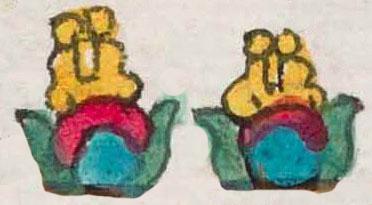xochitl (Mdz24v)
This element has been carved from the compound sign for the place name, Xochimilcatzinco.
Glyphs for flowers are often highly detailed and colorful. The attention to detail and color attest to the high value placed on flowers. The two small circles at the top of this flower, the leaves, and the roots are all hallmarks that will recur with some frequency, but, naturally, this element can also be abbreviated in some compound glyphs (e.g. the example, below, from 23 recto), and it will absorb European depictions of flowers (emphasizing stem, leaves, and largely round flowers) over time. Prior to contact, flowers appeared on temples and palaces, they were cultivated in gardens (showing horticultural expertise), they were associated with a ritualized warfare, worn as necklaces and garlands, and, for these reasons and more, they were the subject of poetry. Mexicolore has a short article about the Nahuas' fondness for flowers.
Stephanie Wood
c. 1541, but by 1553 at the latest

flowers
Codex Mendoza, folio 24 verso, https://digital.bodleian.ox.ac.uk/objects/2fea788e-2aa2-4f08-b6d9-648c00..., image 59 of 188.
The Bodleian Libraries, University of Oxford, hold the original manuscript, the MS. Arch. Selden. A. 1. This image is published here under the UK Creative Commons, “Attribution-NonCommercial-ShareAlike 3.0 License” (CC-BY-NC-SA 3.0).

